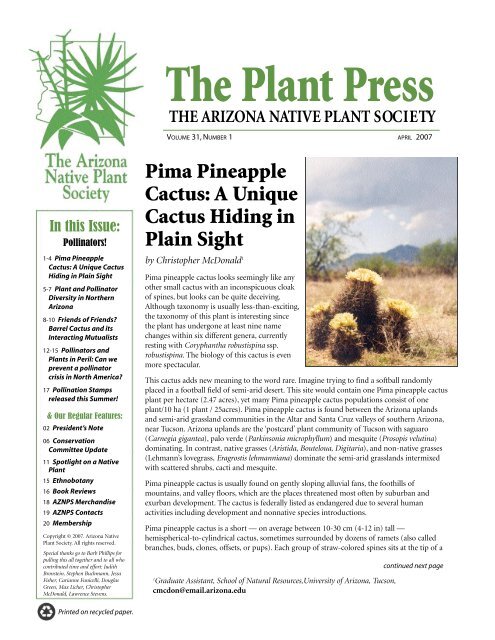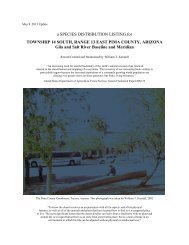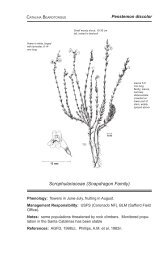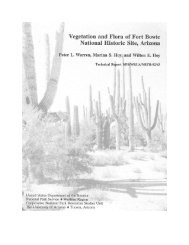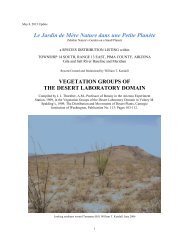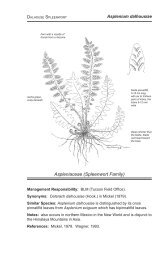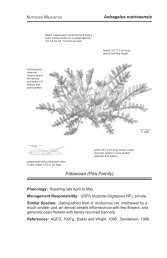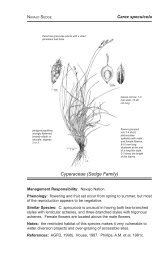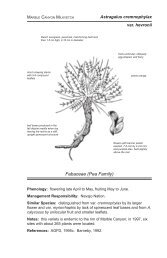The Plant Press AR I ZO NA NAT IVE PLA NT SOC IE TY
The Plant Press AR I ZO NA NAT IVE PLA NT SOC IE TY
The Plant Press AR I ZO NA NAT IVE PLA NT SOC IE TY
- No tags were found...
Create successful ePaper yourself
Turn your PDF publications into a flip-book with our unique Google optimized e-Paper software.
<strong>The</strong> <strong>Plant</strong> <strong>Press</strong>T H E A R I <strong>ZO</strong> <strong>NA</strong> <strong>NA</strong>T I V E P LA N T S OC I E <strong>TY</strong>VOLUME 31, NUMBER 1 APRIL 2007In this Issue:Pollinators!1-4 Pima PineappleCactus: A Unique CactusHiding in Plain Sight5-7 <strong>Plant</strong> and PollinatorDiversity in NorthernArizona8-10 Friends of Friends?Barrel Cactus and itsInteracting Mutualists12-15 Pollinators and<strong>Plant</strong>s in Peril: Can weprevent a pollinatorcrisis in North America?17 Pollination Stampsreleased this Summer!& Our Regular Features:02 President’s Note06 ConservationCommittee Update11 Spotlight on a Native<strong>Plant</strong>15 Ethnobotany16 Book Reviews18 AZNPS Merchandise19 AZNPS Contacts20 MembershipCopyright © 2007. Arizona Native<strong>Plant</strong> Society. All rights reserved.Special thanks go to Barb Phillips forpulling this all together and to all whocontributed time and effort: JudithBronstein, Stephen Buchmann, JessaFisher, Carianne Funicelli, DouglasGreen, Max Licher, ChristopherMcDonald, Lawrence Stevens.Pima PineappleCactus: A UniqueCactus Hiding inPlain Sightby Christopher McDonald 1Pima pineapple cactus looks seemingly like anyother small cactus with an inconspicuous cloakof spines, but looks can be quite deceiving.Although taxonomy is usually less-than-exciting,the taxonomy of this plant is interesting sincethe plant has undergone at least nine namechanges within six different genera, currentlyresting with Coryphantha robustispina ssp.robustispina. <strong>The</strong> biology of this cactus is evenmore spectacular.This cactus adds new meaning to the word rare. Imagine trying to find a softball randomlyplaced in a football field of semi-arid desert. This site would contain one Pima pineapple cactusplant per hectare (2.47 acres), yet many Pima pineapple cactus populations consist of oneplant/10 ha (1 plant / 25acres). Pima pineapple cactus is found between the Arizona uplandsand semi-arid grassland communities in the Altar and Santa Cruz valleys of southern Arizona,near Tucson. Arizona uplands are the ‘postcard’ plant community of Tucson with saguaro(Carnegia gigantea), palo verde (Parkinsonia microphyllum) and mesquite (Prosopis velutina)dominating. In contrast, native grasses (Aristida, Bouteloua, Digitaria), and non-native grasses(Lehmann’s lovegrass, Eragrostis lehmanniana) dominate the semi-arid grasslands intermixedwith scattered shrubs, cacti and mesquite.Pima pineapple cactus is usually found on gently sloping alluvial fans, the foothills ofmountains, and valley floors, which are the places threatened most often by suburban andexurban development. <strong>The</strong> cactus is federally listed as endangered due to several humanactivities including development and nonnative species introductions.Pima pineapple cactus is a short — on average between 10-30 cm (4-12 in) tall —hemispherical-to-cylindrical cactus, sometimes surrounded by dozens of ramets (also calledbranches, buds, clones, offsets, or pups). Each group of straw-colored spines sits at the tip of a1Graduate Assistant, School of Natural Resources,University of Arizona, Tucson,cmcdon@email.arizona.educontinued next pagePrinted on recycled paper.
President’s Noteby Barbara G. Phillips bgphillips@fs.fed.usCoconino, Kaibab and Prescott National Forests, FlagstaffSome of my earliest childhood memories are of pollinators —thebusy non-native honeybees in my family’s orchards of apples,peaches, pears and cherries in Western New York. We had lots ofhives of the bees and my father managed them as a true beekeeper,with smoke, mask and gloves. He also put flowering bouquets ofbranches in barrels at strategic places in the orchards for thosevarieties that required cross-pollination. We ate really dark brownhoney gleaned from the honeycombs. Other memories are of beingstung by insects in the grass while running barefoot through theyards and orchards. Some of those stings came from native bees,bumblebees and wasps because we had a 15-acre woods, creek withnative streamside vegetation, hedgerows and brush piles. Our farmwas not as manicured and filled with non-native plants as corporatefarms today and native species of pollinators also found homes andfood aplenty.Now both native pollinators and the introduced honeybees are inperil as I am sure you have heard on the news. This issue of <strong>The</strong><strong>Plant</strong> <strong>Press</strong> is devoted to pollinators of our Arizona native plants.Pima Pineapple Cactus, our featured plant in this issue, is going toretain its endangered species protection, as announced by the U.S.Fish & Wildlife Service (www.fws.gov/southwest/es/arizona). Iknow you will be fascinated by the complex interrelationship of thisrare cactus with its pollinator as well as its biology and life history.Other articles take us from the top of the San Francisco Peaks toyour own backyard following the diligent research by Arizonabotanists and biologists on native plants and their pollinators.I hope that these articles and the shorter regular columns will bringyou fresh perspectives about pollinators and their problems. Taketime to look up the websites and books mentioned by the authors.<strong>The</strong>re is a wealth of information available on the internet and atwebsites of other organizations such as the Arizona-Sonoran DesertMuseum. Steve Buchmann suggests several ways you can helppollinators in your own gardens. Please note that the ConservationCommittee of AZNPS is actively seeking your input on howAZNPS members can educate their neighbors and homeownersassociations about the value of Arizona plant pollinators within ourcommunities.I want to thank the Board and members of AZNPS, especiallyWendy Hodgson, Les Landrum and Andrew Salywon of theOrganizing Committee, who worked so diligently to put on anotheroutstanding Arizona Botanists/Arizona Native <strong>Plant</strong> Society AnnualMeeting at the Desert Botanical Garden in February. Thanks also toNancy Zierenberg, Rod Mondt and Doug Green for manningAZNPS tables at the event and organizing correlative short andlong fieldtrips. <strong>The</strong> topic of “Ethnobotany and InheritedLandscapes” was very well received by over 150 attendees. A futureissue of <strong>The</strong> <strong>Plant</strong> <strong>Press</strong> will focus on this theme.Coryphantha robustispina ssp. robustispinaPima pineapple cactus continuedtubercle (a finger-like projection) on which rests theareole (the spine-producing structure). Eachtubercle has 10-15 radial spines and one centralspine, which can be slightly curved at the tip. <strong>The</strong>spines are quite strong, hence the species name.Each tubercle has a cleft on the top-side easilydistinguishing this cactus from small barrel(Ferocactus) or pincushion (Mammillaria) cacti.This cactus is unusual in that it can asexuallyproduce many ramets that grow near the base of the‘parent’ plant. <strong>The</strong> number of ramets each Pimapineapple cactus produces varies from none to over100 (rarely), but usually each plant has 3-5 ramets.Some scientists see this variation as alternatives in asurvival strategy — when many ramets areproduced that can outlive the parent plant, there is agreater chance of leaving offspring in the long-term.However, when fewer ramets are produced, the moreenergy the parent plant can invest in reproduction,increasing its chance of producing offspring in theshort-term. Scientists have yet to understand thenatural economics of Pima pineapple cactus.<strong>The</strong> flowers of this species are relatively large — 6-10 cm (2-4 in) across — and are showy with brightyellow petal-like tepals. Flower color can bestunningly variable from pale-yellow, to yellow withred streaks, to salmon. Reproduction is highlyvariable between individuals. Large adult plantsproduce about ten flowers and fruits a year; howeverplants with many ramets can produce 20-30 fruits ina year, as the many smaller plants each produce afew fruit. Each fruit contains about 80 seeds.2 <strong>The</strong> <strong>Plant</strong> <strong>Press</strong> <strong>AR</strong> I <strong>ZO</strong> <strong>NA</strong> <strong>NA</strong>T I V E <strong>PLA</strong> N T <strong>SOC</strong> I E T Y m Ap r il 2007 w w w. a z n p s . org
<strong>The</strong> fruits are about 3 inches long and, after September, turnfrom dark green to light green as they ripen. When mature,the fruits extend beyond the central spines where they areeaten and dispersed by a variety of small- to medium-sizedanimals, including rabbits, squirrels, birds, and even ants.Scientists do not know how successful these animals are atdispersing the seeds.Part of the uniqueness of this cactus stems from itsrelationship with its pollinator Diadasia rinconis. <strong>The</strong> cactusowes much of its livelihood to this medium-sized, furry bee.Unlike the common European honeybee (Apis mellifera)Diadasia females are solitary, dig their nests underground,and each female provisions her own offspring. Many femaleslive in aggregations similar to ‘bee suburbs,’ as the female’snests are close together but each nest is independent. Some ofthe largest known aggregations can house ten thousand beesin only several hundred square feet of space. <strong>The</strong> habitat thatmost Pima pineapple cacti occupy is the also habitat thatDiadasia bees prefer — gently sloping alluvial fans.About the same size as the European honeybee, Diadasia beesare quite fuzzy, tan-brown in color with yellow and brownbands on their abdomens, and have dark green eyes. <strong>The</strong>y arecactus specialists: the females visit plants within the cactusfamily to collect pollen and nectar for their young. <strong>The</strong> beessparingly use other kinds of plant pollen and nectar. Researchhas shown that many Diadasia females will not beginprovisioning their nest unless they have access to cactuspollen.<strong>The</strong> female bee collects cactus pollen and nectar and, after adozen trips visiting possibly hundreds of flowers, she lays oneegg on the large (~1 cm, 0.4 inch) mass of nectar and pollen.She seals the chamber, builds another mass in a separateDiadasia rinconischamber, seals the entrance to the entire nest, and digs a newhole after she provisions about a dozen eggs. She does thiswithout the help of male Diadasia bees, who are apparentlytoo busy finding other mates to be bothered with these tasks.Mating is very important to male Diadasia bees. <strong>The</strong> malesemerge from their underground nests before the females andwait for them to emerge. When a female emerges the malesfight each other to get access to her. Sometimes this results ina ball of males surrounding the female, with all the malespushing and shoving trying to mate. During copulation,which lasts several minutes, the pair produces brief buzzingsounds. If a male Diadasia finds a female that has alreadymated, she is generally left alone. Some vigorous Diadasiamales have been seen attempting to mate with other speciesof bees.Photoscover Monsoon & Pima pineapple cactus.PAGE 3 Diadasia in Pima pineapple cactus.PAGE 4 Pima pineapple cactus flowers and pups.Diadasia bees are quite harmless unless harassed, which iscommon with the vast majority of Sonoran Desert bees.Sometimes a nesting aggregation may be near a homewithout anyone noticing, since the presence of humans doesnot seem to bother the bees. Diadasia females nest in barepatches of soil. Scientists do not know why some sites arechosen to start an aggregation and others of seemingly equalquality are left unoccupied.When pollinating a cactus flower, the behavior of Diadasiafemales is quite distinctive. A female will land on the stigmaof larger flowered cacti — cholla, prickly pear, barrel,hedgehog, saguaro and beehive cacti (Opuntia, Ferocactus,Echinocereus, Carnegia, and other Coryphantha) amongothers. She then climbs down the style to the bottom of theflower, drinks the nectar, collects pollen, climbs back up thestyle, touching the numerous anthers on the way out, andflies to the next cactus flower. Sometimes she will run a fewlaps on top of the anthers collecting pollen before she leaves.continued next pageAp r il 2007 w w w. a z n p s . org m <strong>The</strong> <strong>Plant</strong> <strong>Press</strong> <strong>AR</strong> I <strong>ZO</strong> <strong>NA</strong> <strong>NA</strong>T I V E <strong>PLA</strong> N T <strong>SOC</strong> I E T Y 3
managing this species. Recent research has shown thatDiadasia bees can carry the pollen of Pima pineapple cactirelatively short distances, generally less than 0.8 km (0.5mile). This suggests that corridors are crucial to the longtermsurvival of this rare plant. Corridors of native vegetationwith a variety of cacti species will need to be preserved sonative bees can pollinate disparate populations of Pimapineapple cactus and still obtain enough resources toprovision young. Many scientists agree that corridors areneeded to function as pathways for birds, mammals andreptiles, such as hummingbirds, bobcats and tortoises.However, we are beginning to realize that corridors also needto function as safe havens for pollinators if we intend toprotect populations of the plants they pollinate.In the air she grooms some of the pollen off her furry bodyand moves it to her hind legs. However, some pollen remainson the body having escaped the bee’s grooming efforts.Because of their distinctive behavior and morphology,Diadasia females are quite easy to identify in the field orgarden during their nesting season, April through August.Part of the reason Diadasia females are so successful atpollinating cacti is that on most visits the last thing theirfuzzy bodies touch when leaving a flower is the pollen-ladenanthers and first thing they land on is the sticky stigma readyto receive pollen.Although Diadasia bees visit and use the flowers of Pimapineapple cacti, the truth is the plants are very dependent onthese specific bees, much more than the bees rely on thiscactus. Pima pineapple cacti grow flower buds during thedriest and hottest months, May and June, and bloom duringan unusual time period in the Sonoran Desert, the earlysummer. Most Sonoran Desert plants bloom with the springrains or towards the end of the summer with the ‘monsoons.’However, since very few other cacti are flowering at this timePima pineapple cacti have the nearly undivided attention ofDiadasia females. Scientists are now learning that manypollinator specialists have similar asymmetric relationshipswith their partners.Another unusual characteristic of this plant is that the flowersopen in response to summer rainfall. <strong>The</strong> flowers bloom 5 to7 days after a significant monsoon storm and many plantswill flower on the same day in a synchronous flowering event.More surprisingly is that the flowers only last one day. <strong>The</strong>sesynchronous flowering events happen about four times a yearspanning June through September. Researchers have foundthat the flowers pollinated in June and July are moresuccessful than those that bloom later in the year.Because of the dependency of Pima pineapple cactus on thispollinator, land managers and conservation professionalsneed to consider much more than this single plant when<strong>The</strong> home gardener is one effective and often critical link inthe conservation of plants and pollinators, including Pimapineapple cactus and Diadasia bees. New research suggeststhat bee diversity in suburban areas can be as high as insurrounding natural areas. Many native bees are unnoticed inmost people’s backyards and will provide their pollinationservices at the modest cost of food and shelter. Last summerin my small Tucson garden I counted a dozen genera of beesvisiting flowers, 4 different kinds of bees were building nestsand I am sure I missed many more. <strong>Plant</strong>ing native plantsand creating nesting areas for bees (see additional resourcesbelow) are easy and effective ways of creating beneficial andfun pollinator-friendly gardens.Additional Resources:A great reference on local pollinators, with plans to buildyour own pollinator garden (Editor’s note: see review on page10), in English and Spanish:Chambers, N., Gray, Y. and S. Buchmann, Pollinators of theSonoran Desert, a Field Guide. Arizona Sonora DesertMuseum <strong>Press</strong>, Tucson. 2005.<strong>The</strong> Xerces Society is dedicated to conservation ofinvertebrates. It has several fact sheets on building artificialbee nests in its Pollinator Conservation and Gardeningsections: www.xerces.orgWonderful examples of pollinator gardens for Arizonagardeners are:<strong>The</strong> Arizona-Sonora Desert Museum (Tucson)www.desertmuseum.orgDesert Botanical Garden (Phoenix) www.dbg.orgTucson Botanical Garden www.tucsonbotanical.org<strong>The</strong> Arboretum at Flagstaff www.thearb.orgTohono Chul Park (Tucson) www.tohonochulpark.orgBoyce Thompson Arboretum (Superior)arboretum.ag.arizona.eduA great webpage containing information about solitaryground-nesting bees, including Diadasia rinconis, can befound at desertdiscovery.arizona.edu/bees.html4 <strong>The</strong> <strong>Plant</strong> <strong>Press</strong> <strong>AR</strong> I <strong>ZO</strong> <strong>NA</strong> <strong>NA</strong>T I V E <strong>PLA</strong> N T <strong>SOC</strong> I E T Y m Ap r il 2007 w w w. a z n p s . org
<strong>Plant</strong> andPollinatorDiversity inNorthern Arizonaby Lawrence E. Stevens 1 , Terry L. Griswold 2 ,Olivia Messenger 2 , Warren G. AbrahamsonII 3 , and Tina J. Ayers 4ABOVE Bombus bumblebees are large-bodied native bees that becomeincreasingly dominant at higher elevations. <strong>The</strong>y appear to prefer blue toyellow or white flowers.Introduction<strong>The</strong> study of plant and pollinating insect biology anddiversity in northern Arizona shows how mutualisticrelationships between trophic levels vary across elevation.Over the past decade, we have been engaged in an elevationbasedbiological inventory of Apache, Coconino, Navajo,Mohave, and Yavapai counties in northern Arizona,compiling data on the distribution of native and non-nativeplant and animal taxa there. <strong>The</strong> large data sets now emergingfrom that work provide insight into a number of provocativeecological questions. <strong>The</strong> botanical work is nearingcompletion, with likely more than 90 percent of the region’splant species documented. However, the inventory is still farfrom complete for insects, including pollinators. Nonetheless,sufficient data have been assemble to allow us to presentsome preliminary analyses of plant and bee diversity acrosselevation in northern Arizona.<strong>Plant</strong> Biodiversity across ElevationWith more than 2000 species, the vascular plant diversity ofnorthern Arizona is simply enormous. <strong>Plant</strong> diversity here isstrongly influenced by elevation, which ranges from 350 to3800 m (1150 to 12,633 ft). Although elevational zonation oftrees has been recognized since the 1890s through the work ofC. Hart Merriam, basic elevation patterns of flowering plantdiversity in northern Arizona have received relatively littleattention. Important questions exist as to whether plantspecies other than trees are tightly organized into “life zones,”and how plant diversity influences the diversity of other taxaacross elevation. To address such questions, Stevens,Abrahamson and Ayers are compiling data on the elevationaldistribution of plants in northern Arizona from herbaria,available databases, and field transects. Thus far they havecompiled elevation range data on 2,030 plant taxa in theregion. Overall, these data indicate that vascular plantdiversity is strongly non-linearly related to elevation, with thehighest number of species occurring between 1500 and 2000m (4900-6500 ft) elevation (Fig. 1).Studies of biodiversity require understanding how habitatarea affects species richness: larger habitats generally supportlarger numbers of species. To understand habitat arearelationships in relation to plant species diversity, weconducted a geographic information analysis to determinehow much land surface area exists within 100-m elevationbelts across northern Arizona. To adjust diversity for thestrength of this species-area effect, we calculated vascularplant species density/km 2 for northern Arizona. A plot of thenumber of plant species within each elevation belt as afunction of the land surface area within that beltdemonstrates (as expected) a strong positive relationship(Fig. 2).Pollinator DiversityPollinating insect diversity is also remarkably large in the arid,topographically diverse habitats of northern Arizona. To date,Griswold, Messenger and Stevens have documented at least533 species of bees (Hymenoptera: Apoidea) in six families inApache, Navajo, Coconino, Mohave and northern YavapaiCounties. Of these, the only non-native species is theEuropean honeybee (Apidae: Apis mellifera), which isextremely common and may out-compete native bees insome situations. <strong>The</strong> Mohave-Sonoran Desert is renownedfor having the highest diversity of several other pollinatingHymenoptera in North America, including not only bees, butalso spider wasps (Pompilidae) and velvet ants (Mutillidae).Additionally, many species of thread-waisted (Sphecidae),crabronid, and vespid wasps are found there. In addition,Stevens (unpublished data) has recorded more than 130species of butterflies and skippers, and the diversity ofpollinating flies and beetles also is large in the region,although taxonomic progress to verify their diversity has beenslower.continued next page1Curator of Ecology & Conservation, Museum of NorthernArizona, farvana@aol.com; 2 USDA-<strong>AR</strong>S Bee Biology &Systematics Laboratory, Utah State University,tgris@biology.usu.edu, Olivia@biology.usu.edu; 3 Dept. ofBiology, Bucknell University, abrahmsn@bucknell.edu; 4 Dept. ofBiological Sciences, Northern Arizona University,Tina.Ayers@nau.eduAp r il 2007 w w w. a z n p s . org m <strong>The</strong> <strong>Plant</strong> <strong>Press</strong> <strong>AR</strong> I <strong>ZO</strong> <strong>NA</strong> <strong>NA</strong>T I V E <strong>PLA</strong> N T <strong>SOC</strong> I E T Y 5
CONSERVATION COMMITTEE UPDATEIs the nativehabitat in youryard under attack?by Carianne Funicelliconservation@aznps.orgAZNPS Conservation Chair<strong>The</strong> Grow Native: Don’t <strong>Plant</strong> a Pestpublic education campaign has been ahuge success — since August of 2006we have distributed over 50,000brochures in English and Spanish tolocal governments, home owner’sassociations, schools, nurseries, andconservation organizationsthroughout southern Arizona. (If youare new and not familiar with thiseffort, check out our website at:www.aznps.org/invasives/GrowNative/invasives.html.)Even so, butterfly and hummingbirdgardeners in many neighborhoodsacross Arizona are finding that theirneighborhood rules are notnecessarily supportive of native plants.For example, one managementcompany in Marana regularly featuresan article in their newsletter abouttheir position that “wildflowers areweeds.” Residents are actuallyreceiving citations for having nativewildflowers in their yards, althoughironically those with non-nativeinvasives such as African sumac (Rhuslancea) and fountain grass(Pennisetum setaceum) are deemedacceptable. Clearly we have our workcut out for us in educating theseentities about not only the dangers ofinvasive ornamentals, but the value ofnative plants in residential landscapes.<strong>The</strong> conservation committee is gettingvery interested in finding ways (inaddition to the brochure andpresentations) to bring about a nativeplant paradigm shift. Please shareyour ideas and experiences with us —we would like to hear about what ishappening from across the state!Email us at conservation@aznps.org.<strong>Plant</strong> and Pollinator Diversity continuedWe have assembled sufficientinformation on bee diversity toaddress a basic question of howpollinator diversity is related to plantdiversity, and how that relationshipvaries across elevation. Using theUSDA and M<strong>NA</strong> bee databases, wecalculated elevation ranges of beespecies for which sufficient data exist(367 of the 533 bee species). We founda strong negative relationship betweenbee diversity and elevation (Fig. 3).That analysis gave us the opportunityto look at the area-adjusted ratio ofbee species diversity in relation to thatof vascular plants, the first time thishas been done in the Grand Canyonregion to our knowledge. This analysisrevealed a strong negative response ofbee:plant diversity across elevation(Fig. 4). Uppermost elevations areextremely limited in area, andalthough bee diversity drops to onlyone species, the species arearelationship is anomalously skewedupward by that statistical artifact from3500-3700 m elevation. Nonetheless,the overall strength of the patternsuggests that bee pollinator diversitydeclines with elevation relative to thatof plants, and thus plant speciessupport relatively fewer bee species athigher elevations.DiscussionReporting such a bold pattern innature is an invitation for scientists toattempt to falsify that pattern and seekthe most parsimonious explanation.Bee-to-plant diversity variation acrosselevation is likely to be attributable tonumerous factors. One couldhypothesize that host-plantspecialization might be more commonamong pollinators at higherelevations, resulting in fewer pollinatorspecies/plant species. However, thatdoes not appear to be the case:although bee diversity naturallydecreases at higher elevations as aresult of the thermodynamicchallenges, montane bees appear to beeven broader generalists than those atlower elevations. Improvedunderstanding of floral usespecialization by bees is needed tomore fully test that hypothesis.Temperature is the most commonfactor affecting the distribution ofectotherms, such as pollinating insects.<strong>The</strong> alpine growing season isnotoriously short: native bee diversityis bimodal in the desert, with springand fall periods of emergence, but isrestricted to a single, relatively briefmid-summer peak at high elevations.<strong>The</strong> short duration of the alpinegrowing season likely greatly restrictsthe effectiveness of bees as pollinators,and colder temperatures mean thatonly the hardiest bees can survive andfunction there. <strong>The</strong> Transition andCanadian forest meadows on the lowerand middle slopes of the San FranciscoPeaks support a relatively richassemblage of bumblebees (Apidae),including Bombus morrisoni, B.rufocinctus, B. occidentalis, B. fervidus,and B. huntii. However, only Bombuscentralis and Colletes simulans(Colletidae) appear to take on theextreme cold and wind above treeline.<strong>The</strong>se all are relatively large-bodiedbees with dense coats of hair-likespines that afford them some ability toconserve heat, a necessity in coldmontane temperatures.It is not only the severity of theweather that affects alpine pollinators,but also climatic variability. Athemistor placed at the top of the SanFrancisco Peaks showed that airtemperature there ranged over 37°C(100°F) within a four-day period threetimes during from October 2003through June 2004. Highly erraticweather patterns above treeline requirethat pollinators have specificemergence and behavioral responsesto temperature, day length, and otherclimate factors. However, sincebumblebees and other alpine bees nestin the ground, they may be able towait out bad weather and emergeduring brief sunny periods. <strong>The</strong>seemergence and behavioral adaptations6 <strong>The</strong> <strong>Plant</strong> <strong>Press</strong> <strong>AR</strong> I <strong>ZO</strong> <strong>NA</strong> <strong>NA</strong>T I V E <strong>PLA</strong> N T <strong>SOC</strong> I E T Y m Ap r il 2007 w w w. a z n p s . org
may help them cope with the vagaries of alpineclimate.Other factors also are likely play a role in this plantpollinatordiversity pattern. For example, theproportion of angiosperms that outcross may belower, potentially in reciprocal response to lower beediversity in harsh alpine environments. Pollinationmay shift toward flies and beetles, away from bees.Also, the proportion of anemophilous (windpollinated)plants may be greater at high elevations,and such species do not require insect pollinators.Also, what about the role of flower color? Unlikehumans, insects perceive ultraviolet wavelengths oflight. Yellow (e.g., Senecio spp.) and white flowers arecommon above treeline, but what is the relativeabundance of blue and red flower colors there?Global climate change, and particularly the patternof increased variation in weather patterns, may havea stronger immediate impact on short-livedpollinators than on their longer-lived host plants.However, because native bees may be responsible forplant reproductive success, and because bee diversityis relatively lower at high elevations, climate changesmay relatively quickly exact a larger impact onmontane vascular plant floras, as compared to thoseat lower elevations.With an improving inventory of northern Arizona’sbiota we can begin to examine, test, and explainthese pollination pattern more fully, and addressother basic and applied pollinator researchquestions. Some of those questions include: thebiodiversity of pollinators other than bees, hostplantspecificity across elevation, the impacts ofnon-native honeybees on native pollinatorpopulations, and the impacts of global climatechange on pollinator distribution and populationdynamics. We look forward to continued researchinto these and other biodiversity topics in northernArizona’s extraordinary array of natural and alteredhabitats.AcknowledgementsWe thank the staff of the many federal agencies, volunteers, andassistants who have supported our work or otherwise helped with ourdata compilation, particularly Mr. Chris Brod for his assistance withGIS analyses.Ap r il 2007 w w w. a z n p s . org m <strong>The</strong> <strong>Plant</strong> <strong>Press</strong> <strong>AR</strong> I <strong>ZO</strong> <strong>NA</strong> <strong>NA</strong>T I V E <strong>PLA</strong> N T <strong>SOC</strong> I E T Y 7
Friends of Friends? Barrel Cactus and itsInteracting Mutualists by Judith L. Bronstein 1 and Joshua H. Ness 2<strong>Plant</strong>s require the services of animals to accomplish some oftheir most essential life functions. Animals do not providethese activities out of an interest in benefiting the plants:rather, they are generally paid handsomely for their services.<strong>The</strong> best-known of these mutually beneficial exchanges(mutualisms) are pollination, in which animals receive anectar reward for moving pollen between flowers, and seeddispersal, in which they transport seeds away from the plantwhile feeding on the surrounding fruit. A third, less wellknownmutualism takes place on certain plants (includingspecies in over ninety plant families) that secrete nectar fromspecialized organs located away from the flowers (extrafloralnectaries). Ants are attracted to and feed upon this nectar,while aggressively defending their food source fromorganisms attempting to consume the plant. In effect, theseplants use ants to conduct “biological warfare” on theirenemies.<strong>The</strong>re are plenty of examples of all three kinds of mutualismin North American desert plants. Let us consider just thecacti. Although our more spectacular columnar cacti,Figure 1a. A male Lithurgus, a specialized cactus bee in thefamily Megachilidae (leafcutter bees), burrowing deep into aflower of the fishhook barrel cactus, Ferocactus wislizeni, tocollect nectar. Upon emerging he will be covered with pollen,which will be transported to the next flower he visits. Photo byJosh Ness.including saguaros, are pollinated by vertebrates such as batsand white-winged doves, insects are the chief providers ofthis service. In fact, the southwestern deserts have the highestdiversity of bees on the planet; many of them serve as criticalpollinators for prickly pears, chollas, pincushion, and barrelcacti. Animal-mediated seed dispersal in desert habitats ismuch less prominent. However, the few species that doproduce juicy, sugary fruits, including saguaros and pricklypears, are particularly important because they likely subsidizemuch of the desert vertebrate community at times whenother water sources are scarce. Finally, essentially all of oursouthwestern cacti take a “biological warfare” approach todefending themselves. <strong>The</strong> extrafloral nectar is secreted fromsmall organs located near the buds, fruits and flowers; theants that collect it appear to be particularly important indefending the cacti from insects that might otherwise feed onthese delicate reproductive organs.For several years, we and our colleagues have been studyingthe diverse animals that exchange benefits with the fishhookbarrel cactus, Ferocactus wislizeni, around southern Arizona.Here we wish to focus on its pollinators and the antdefenders, as well as on how they interact with each other.1Department of Ecology and Evolutionary Biology, University ofArizona; 2 Department of Biology, Skidmore College8 <strong>The</strong> <strong>Plant</strong> <strong>Press</strong> <strong>AR</strong> I <strong>ZO</strong> <strong>NA</strong> <strong>NA</strong>T I V E <strong>PLA</strong> N T <strong>SOC</strong> I E T Y m Ap r il 2007 w w w. a z n p s . org
Fishhook barrel cacti produce a memorable displayof bright yellow, orange and red flowers during themonsoon season. <strong>The</strong>se flowers attract a variety ofvisitors that may collect both pollen and nectar.Perhaps surprisingly, visits by butterflies, flies, andthe ubiquitous European honeybee provide nobenefit. Only a few specialized bee species (‘cactusbees’) successfully pollinate these flowers (Fig. 1a).(Chollas and prickly pears depend on many of thesesame bees.) We find it fascinating that a plant thatattracts so many visitors benefits from so few ofthem, and that the reproduction of the plant is in thehands (or, rather, legs!) of only a few native beespecies.<strong>The</strong> extrafloral nectaries of fishhook barrel cactus areraised, bright-yellow bumps located in several ringson the top of the plant; they are highly modifiedspines. If you look closely at the top of a barrelcactus, you are likely to see anywhere from a few tonearly a hundred ants intermittently feeding at thesenectaries (Fig. 2). At every site we have checked, there are abouteight to ten different cactus ant species; one group of speciescharacterizes desert sites, while another is found in grasslandhabitats. Each individual barrel cactus, however, is almostalways dominated at any one time by only one ant species. If anintruder ant species wanders onto the plant, it is promptlyattacked by the residents. <strong>The</strong> resident species can tend thatplant for months at a time, for, unlike virtually all othersouthwestern cacti, fishhook barrel cactus secretes extrafloralnectar year-round rather than only during its reproductiveseason. Cactus ants range in quality from excellent defenders tovirtual freeloaders; barrels occupied by the most effectivedefender ants do in fact reproduce more.<strong>The</strong> three different forms of plant/animal mutualism that wehave discussed have been studied by ecologists for manydecades, but almost always in isolation from one another. Thisis curious, because the same plant individual may often beinteracting with animals conferring different kinds of benefit atthe same time. How do the different groups of mutualiststhemselves interact? For instance, one might expect the cactusants and cactus bees that share a barrel to stay out of eachother’s way, or even to cooperate somehow, since a healthy plantis in their mutual interest. Is this actually the case? That is, arethe friends of my friends really my friends too, as human naturewould lead us to believe?We are getting some very surprising results in this regard.Certainly, a better-defended barrel cactus bears less damagedflowers (compare Figures 1a and 1b). In this regard, antdefenders do benefit the cactus’s pollinators. More indirectly,pollination leads cacti to reproduce more, which in the distantfuture will benefit cactus ants (since they will have moreextrafloral nectar-producing cacti to feed upon). Looked at thisway, cactus ants and cactus bees do benefit each other, byFigure 2. An ant, Crematogaster opuntiae, visiting anextrafloral nectary on a barrel cactus. Photo by Will Wilson.independently increasing the success of the resource theyshare. But consider a much shorter-term scale. Whathappens when ants and bees feed on the same cactus at thesame time? We are discovering that the result depends onwhich ant species happens to be defending the plant.Crematogaster opuntiae, a small black ant, is one verycommon barrel cactus associate (Figure 2). We noticed thatthis species almost never enters barrel flowers. Furtherexperiments showed that a chemical in the petals of barrelcactus flowers is quite repellent to this ant. When we rubflower petals over half of a dish and let Crematogaster looseon it, they will actively avoid that part of the dish.Crematogaster, then doesn’t get in the way of the pollinatorsat all.We have, however, found something very different withanother common cactus ant, Solenopsis xyloni. Thisferocious little defender is a close relative of the invasive fireant; it is native to our region but seems to be spreadingrapidly, for reasons we do not yet understand. Solenopsis isvery, very good at getting rid of cactus herbivores. In thatsense, it is a valuable partner to the cactus. Unfortunately, itis also very good at getting rid of pollinators. This ant hasno compunction whatsoever about entering cactus flowers.While there, it feeds on nectar and pollen. It also attacksbees. In fact, we have seen cactus bees flying around withSolenopsis heads still clamped to their legs! Bees areexcellent learners. We have found that they visit theseparticularly dangerous flowers more rarely, and spend lesscontinued next pageAp r il 2007 w w w. a z n p s . org m <strong>The</strong> <strong>Plant</strong> <strong>Press</strong> <strong>AR</strong> I <strong>ZO</strong> <strong>NA</strong> <strong>NA</strong>T I V E <strong>PLA</strong> N T <strong>SOC</strong> I E T Y 9
Barrel Cactus and its InteractingMutualists continuedFigure 1b. Grasshoppers cover this barrel cactus and have heavilydamaged the flowers on this individual, located at a site unusualfor lacking effective ant defenders.Barrel Cactus and itsInteracting Mutualists continuedtime there when they do visit. Our studies are showing thatbarrel cacti tended by this ant species are very well-defendedand produce more fruits. However, these fruits include fewerand smaller seeds than fruits from plants tended by other antspecies. In this case, then, two sets of mutualists of the sameplant species are decidedly not friends — apparently, to theirown detriment.We have much to learn about these interactions, bothseparately and in association with each other. Which ant isthe better mutualist for barrel cacti? Crematogaster doesn’tdefend the plant as well as Solenopsis, but at least it doesn’tdiscourage pollination; Solenopsis scares away everyone,enemies and friends alike. Why is Crematogaster repelled bythe flowers, while Solenopsis is not? Why do barrel cactiproduce extrafloral nectar year-round when the benefits thatants provide seem to accrue only during the fairly shortreproductive period, when flowers, buds, and fruits requireprotection? Finally, do barrel cacti have any control overwhich ants and bees they attract and how those insectsinteract with each other, or are they passive players in thesegames?While the spectacular flora of the desert is readilyappreciated, the small invertebrates upon which these desertplants depend are quite easy to overlook. Cactus bees andants provide basic services to the plants, although theseinteractions seem to be changing as ‘weedy’ species, such asexotic fire ants and European honey bees, becomeincreasingly common (albeit poorer) partners to the plants.We hope that this article has provided one glimpse into thecomplex and subtle networks of relationships, both friendlyand antagonistic, that shape the flora we see today.Photo 1. Type locality of Arizona bugbane on Bill WilliamsMountain. Courtesy Barbara Phillips.Photo 2. Flowering Arizona bugbane plants. Courtesy BarbaraPhillips.1 0 <strong>The</strong> <strong>Plant</strong> <strong>Press</strong> <strong>AR</strong> I <strong>ZO</strong> <strong>NA</strong> <strong>NA</strong>T I V E <strong>PLA</strong> N T <strong>SOC</strong> I E T Y m Ap r il 2007 w w w. a z n p s . org
SPOTLIGHT ON A <strong>NA</strong>T<strong>IVE</strong> <strong>PLA</strong><strong>NT</strong>Arizona Bugbaneby Barbara G. Phillips bgphillips@fs.fed.usCoconino, Kaibab and Prescott National Forests, FlagstaffArizona bugbane (Cimicifuga (Actea) arizonica) is afascinating member of the Buttercup (Ranunculaceae)family. It is a relict from the Miocene, endemic to fourdisjunct population areas in northern and central Arizona.Bill Williams Mountain, the highest site at 8300 feet (2515m), is the type locality where it was first collected in August1883 by H. H. Rusby. Mr. and Mrs. J. G. Lemmon alsocollected it there in a ravine on the north slope (Photo 1).This population is protected by the Kaibab National Forestin a Botanical Area. <strong>The</strong> West Fork of Oak Creek and itsside tributaries hold the bulk of the sites. <strong>The</strong>se are in theWest Fork of Oak Creek Research Natural Area and RedRock-Secret Mountain Wilderness. Another populationarea is within the West Clear Creek Wilderness Area andthe fourth population is in the Sierra Ancha Mountains.<strong>The</strong> typical habitat is moist shady canyons with mixedconifers and deciduous trees with a diverse herbaceousunderstory and lots of duff. <strong>The</strong> high relative humidity isimmediately noticeable when entering the vicinity andlichens hang off the trees. Canyon walls and cliffs usuallyprovide shade during most of the days and during thewinter the sites are usually snow-covered for long periodsof time.<strong>The</strong> herbaceous perennial plants have rhizomes thatelongate horizontally through the soil, palmatelycompound leaves, and grow up to 6 feet (1.8 m) tall (Photo2). It is often difficult to determine individual plantsbecause the underground relationships of the stems andrhizomes cannot be determined without excavation.According to Olle Pellmyr, a Swedish biologist who studiedthe American bugbanes in the 1980’s, the floral structuresin the Ranunculaceae have evolved in parallel with evolvingpollinators. <strong>The</strong> Cimicifuga genus belongs to an archaicspecies group within the family. <strong>The</strong> flowering racemeconsist of small white flowers each of which has about 50-70 stamens that have long filaments and form most of thevisual display. <strong>The</strong> numbers of carpels per flower vary fromone to four. <strong>The</strong>re are no petals and the sepals fall off oneday after floral opening. Four orders of insects(Hymenoptera, Lepidoptera, Diptera and Coleoptera) visitArizona bugbane. However, social bees, and especiallybumblebees (Bombus occidentalis, Separatobombusmorrisoni and Probombus huntii), are almost exclusively thepollinators. <strong>The</strong> bumblebees alight preferentially in theupper part of the open flowers where pollen is mostabundant. <strong>The</strong>y run in a spiral over the inflorescence,pressing their bodies against the flowers. Pollen adheres tothe legs and to the hairy underside of the hind section ofthe thorax and the abdomen. <strong>The</strong> stamens are depressedseveral millimeters and the stigma is stroked by the pollenladenbody, effecting pollination.Some bumblebees buzz the flowers, i.e. use flight musclesto bring the anthers into rapid vibration. Pellmyr observedthe bees repeatedly grasping bundles of five to ten undehiscedstamens, pressing them against their bodies,putting their wings in resting position over the abdomenand buzzing loudly for one or a few seconds. Reasonablymature anthers burst open so that the bees got considerableamounts of pollen.<strong>The</strong> pollinators of Arizona bugbane visited severalflowering species simultaneously, including phacelia(Phacelia magellanica), beebalm (Monarda fistulosa), showymilkweed (Asclepias speciosa), goldencolumbine (Aquilegia chrysantha)and Richardson’s geranium(Geranium richardsonii). Undernormal conditions Arizona bugbaneflowers receive a very limited numberof visits by its pollinators so it isessential to maintain a diversity ofplant species so that the bees will bein the area when Arizona bugbane isflowering.PHOTOS THIS PAGE Floral racemes ofArizona bugbane, with insects onright photo. Courtesy Max Licher.Ap ril 2007 w w w. a z n p s . org m <strong>The</strong> <strong>Plant</strong> <strong>Press</strong> <strong>AR</strong> I <strong>ZO</strong> <strong>NA</strong> <strong>NA</strong>T I V E <strong>PLA</strong> N T <strong>SOC</strong> I E T Y 1 1
Pollinators and <strong>Plant</strong>s in Peril: Can weprevent a pollinator crisis in North America?by Stephen Buchmann 1 Photos courtesy the author.We are losing many of our native plants and their pollinatorsat ever-increasing rates in the Sonoran Desert and otherlands. A 2006 European study found that populations ofnative bees and flower flies had dropped 40–60% in studyplots from the United Kingdom and <strong>The</strong> Netherlands duringthe last decade. <strong>The</strong>se are alarming and widespreaddownward trends. Unfortunately, the same things areprobably happening in the United States but we don’t havethe background baseline data to support the widespreadbelief that we have lost and are losing many pollinators tolocal extirpations or outright extinction.Photo Xylocopa (carpenter bee) with the world's smallestbee, Perdita minima from the Sonoran desert.Around the globe, at least two hundred thousandinvertebrates, mostly bees and other flying insects, and over1,000 vertebrates — nectar-feeding birds, bats and a few nonvolant(flying) mammals — pollinate most of the world’squarter million angiosperm species. <strong>The</strong>se sexual gobetweensmove pollen from flower to flower, effectingpollination and subsequent fertilization during their foodcollectingactivities for themselves and their broods (pollen,nectar, oils), or other activities for substances used as buildingmaterials or sex attractants (resins, and fragrances). We oweroughly a third of our diet along with the production ofmany fibers, beverages, medicinals and nutraceuticals to theworld’s pollinating animals. Less than 20% of floweringplants utilize wind or water to vector pollen grains betweenblossoms, although wind-pollinated (anemophilous) cerealcrops are critically important as our dominant food plants.At first glance, the rocky low elevation slopes ofenvironments like the Tucson Mountains west of theadvancing metropolis don’t appear to be a Sonoran Desertbiodiversity hotspot. But, like so many mountain habitat “skyislands,” the Tucson Mountains boast over 600 species ofnative flowering plants along with a host of insects and other1Department of Entomology,<strong>The</strong> University of Arizona.1 2 <strong>The</strong> <strong>Plant</strong> <strong>Press</strong> <strong>AR</strong> I <strong>ZO</strong> <strong>NA</strong> <strong>NA</strong>T I V E <strong>PLA</strong> N T <strong>SOC</strong> I E T Y m Ap r il 2007 w w w. a z n p s . org
invertebrate animals. Not one complete survey for anysite has been made but I predict the Tucson basin andits surrounding bathtub ring of mountain ranges arehomeground to at least 500 species of ground-living ortwig-nesting native bees. Arizona undoubtedly has over1,000 bee species, and might lay title to the richest beereal estate on the planet. Israeli deserts and the Caperegion of South Africa would also be top contenders.<strong>The</strong>re are almost 20,000 described bee speciesworldwide and the continental United States is home to4,000 native bees. Arizona has what may be the world’ssmallest bee — Perdita minima, under two mm (.078inch) in length — which visit and pollinate flowers ofsandmat euphorbs (e.g. Chamaesyce). Melittologists noticethese bees by the shadows they cast on the ground and needan ultra-fine net to catch and hold them.In a book entitled <strong>The</strong> Forgotten Pollinators (Buchmann andNabhan 1997), I, along with ethnobotanist Gary Nabhan,called attention to what we noticed as declines, extinctionsand regional extirpations of pollinators and their plants.During that period we co-founded and directed the ForgottenPollinators Campaign from the Arizona-Sonora DesertMuseum and built public education pollinator gardens.Today, my conservation efforts are with the North AmericanPollinator Protection Campaign and its memberorganizations (see www.napp.org and www.pollinator.orgfor more information and educational resources). Sadly, thesame threats that were impinging on plants and pollinatorseleven years ago (habitat loss and modification due toincreasing urbanization and agriculture, pesticide use,competition from invasive non-native plants and animals)have not gone away. If anything, these driving factors haveworsened in their impacts on our native Arizona biotas.We now know of several pollinator extinctions, especiallyamong flower-visiting butterflies (see the Xerces Society RedList at www.xerces.org/Pollinator_Red_List/index.htm). Inthe Hawaiian archipelago, at least seven species of smallnative bees (Yellow-faced bees; Nesoprosopis spp.) have goneextinct due to habitat loss and ecological degradation. Evenamong our charismatic black and yellow bumblebees changesare occurring rapidly. Franklin’s bumblebee (Bombusfranklini) from the Pacific northwest States of Washingtonand Oregon has likely gone extinct in the past few years.Despite intensive searches throughout its former small range,no workers, queens or colonies have been found by beeexperts. Bumble bee species that were omnipresent andabundant in the coast and interior ranges of California whileI was a graduate student at the University of California atDavis are now exceedingly rare, if they can be found at all. Inthe western United States, Bombus occidentalis, and in theeast, B. affinis, bumblebees have disappeared across much oftheir former ranges beginning in the late 1990s. <strong>The</strong>se lossesare presumably due to infection with introduced colonyparasites (the protozoans Nosema and Crithidia spp.) fromtheir contact with commercially-reared bee colonies used forPhotos LEFT What may be the mostbeautiful Sonoran bee, Centris eisenii,collecting floral oils from a malpigh blossom(Mascagnia/Callaeum macroptera). RIGHT Amale Centris pallida bee. This species visitsand pollinates palo verdes (Cercidium spp.).greenhouse pollination of tomatoes. Greenhouses arenotoriously “leaky” for managed bee colonies used forpollination.One of the least appreciated, but most lethal, threats to ournative Arizona pollinators and their plants are direct andindirect ecological pressures: competition from non-native(introduced) plants and animals, many of which have becomeestablished. Certainly one of the worst is buffelgrass(Pennisetum ciliare) purposefully introduced by the USDAinto Arizona in the 1930s as a potential fodder plant forlivestock. It now chokes thousands of hectares in Sonora,Mexico, and many sites (for example Tumamoc Hill; see therecent <strong>Plant</strong> <strong>Press</strong> article by Travis Bean and Julio Betancourt,February 2006). This plant is a major threat to our nativeSonoran Desert plants and many animals. It forms a greensea of stems sucking up water and forcing out other plants.Most native bees require open bare ground for nesting, andabout 10% of our other bees form a guild of twig-nesters thatutilized abandoned beetle burrows in dead trees, or some likecarpenter bees (Xylocopa spp.) that excavate their owngalleries in Agave, Dasylirion, Yucca or soft timbers likeFremont’s cottonwood (Populus fremontii). An insidiousproperty of buffelgrass is its ability to carry hot wildfires,something that our native desert plants have neverexperienced. Fires are especially damaging to our native cactiand small leguminous trees. No studies are underway, butinvasive plants like buffelgrass will undoubtedly have a majornegative impact on native desert bee, and other pollinatorcommunities. Want revenge? Join the Sonoran Desert WeedWhackers and get even (see www.aznps.org).Even introduced bees are causing problems. “Aren’t all beesgenuinely beneficial, or at least harmless?” We tend to thinkof all bees as generally helpful, in fact keystone organisms inplant communities and natural biomes. But some introducedbees, especially those with wide dietary breadth (e.g. bumblebees, some digger bees and honey bees; they are calledpolylectic) negatively impact other bees and native plants.<strong>The</strong>re are 22 species of exotic bees now established in thecontinental United States. Hawaii alone has 15 species ofintroduced and naturalized exotic bees. <strong>The</strong> most pervasive ofthese is the introduced European honey bee (Apis mellifera).Of course honey bees are crucial, often the only managed,continued next pageAp ril 2007 w w w. a z n p s . org m <strong>The</strong> <strong>Plant</strong> <strong>Press</strong> <strong>AR</strong> I <strong>ZO</strong> <strong>NA</strong> <strong>NA</strong>T I V E <strong>PLA</strong> N T <strong>SOC</strong> I E T Y 1 3
LEFT An oxaeid bee — a female Protoxaea gloriosa collectingnectar and pollen from a Kallstroemia grandiflora blossom.“Where’s the pollen?” It is important when planting forpollinators to plant in clumps of six of more plants instead ofindividuals. Also try to plant species that bloom continuously,or for long periods of time, from spring into our fall months.Using few or no insecticides on your property will alsobenefit bees and other pollinators. Reduce your impact, yourcarbon footprint. Walk or ride a bicycle now and then.Buying local and organic produce helps farmers andpollinators.Pollinators and <strong>Plant</strong>s in Perilcontinuedpollinators for the more than 100 major crop plants grown inthe United States, but few people other than some ecologistsand conservation biologists realize their downside (e.g.competition for floral resources and nesting sites, spreadingweedy plants by pollinating them, competition with otherpollinating animals). <strong>The</strong> negative effects of advancingAfricanized bee populations are especially dramatic onpeople, native plants, and animals. Some organizations andnatural parks in Arizona have made attempts to remove feralbee colonies in rock outcroppings because they are not partof our native insect fauna.What can we do to protect and conserve our nativebees, and other pollinating animals?All is not gloom and doom, but we must be vigilant and takeaction. <strong>The</strong>re are a few simple things that land andhomeowners, land managers and policy makers can do toassure that we protect and conserve our native bees, andother pollinating animals. First, habitat protection is the mostimportant step: retaining as much contiguous desert lands aspossible. Whenever landscaping or wildflower gardening ispracticed, native Sonoran Desert plants should be used. <strong>The</strong>seplants are adapted to the climate, soils and growingconditions found in Arizona. <strong>The</strong>y are minimummaintenance survivors which need no pampering withaugmentative fertilizer applications or massive amounts ofirrigation water. <strong>The</strong>y are resistant to local pests and diseases.Use them. Often, when horticultural varieties, especiallymodern hybrids (double or triple flowers anyone?), are used,these cultivars may have been inadvertently selected out forfloral volatiles, or worse; even the very pollen and nectar thatwe would expect. Sometimes, you can spend a fortune onlandscaping plants only to have pollinators show up and ask,Dead limbs or entire trees (e.g. mesquites and palo verdes)are often considered “eyesores” in managed or wild habitats.Think again. <strong>The</strong>se are crucial resources for bees, wasps andother wildlife (lizards, birds, mammals). Holes of variousdiameters commonly found in dead limbs are left as exitholes by emerging adults of native beetles. Many native beesare incapable of tunneling their own nests. Instead, theydepend upon these ready-made tunnels carved out by theformer beetle tenants. Gardener or woodcutter, spare thatlimb and you will help build or re-build essential populationsof pollinating bees, wasps and other insects.Similarly, you can build a “bee condominium” to enticepollinating twig-nesting bee guilds into your area. Manyspecies of native leafcutter and mason bees (the generaMegachile and Osmia) are very abundant, especially insoutheast Arizona, both in town and in the surroundingdesert. <strong>The</strong>y readily take up occupancy in man-madedomiciles. Simply take thick pieces of wood or scrap lumberand drill holes into them. <strong>The</strong> holes should be 3-5 inchesdeep and not emerge from the backside of the wood. Vary thediameters from 2 to 10 mm. Hole diameters of 7–8 mm areespecially attractive to our AZ bees. Securely attach yourdrilled board bee nests under the eaves of your house or anout building, protected from direct sun and rain.Females of these wood-nesting bees can sting, but usuallydon’t. <strong>The</strong>y won’t come after you like honey bees sometimeswill. Relax and let them entertain you and your family.Female bees returning home with leaf pieces, resin or brightyellow pollen loads are great fun to watch. <strong>The</strong>y can bewatchable wildlife on your patio. In addition to hummingbirdfeeders, bee nests make great family, school or scoutingprojects.Selected ReferencesBiesmeijer JC, Roberts SPM, Reemer M, Ohlemuller R,Edwards M, Peeters T, Schaffers AP, Potts SG, Kleukers R,Thomas CD, Settele J, and Kunin WE (2006): "Paralleldeclines in pollinators and insect-pollinated plants inBritain and the Netherlands." Science 313 (5785): pp. 351-354Buchmann, S.L. and J.S. Ascher. <strong>The</strong> plight of pollinatingbees. 2005. Bee World, September, 71-74.1 4 <strong>The</strong> <strong>Plant</strong> <strong>Press</strong> <strong>AR</strong> I <strong>ZO</strong> <strong>NA</strong> <strong>NA</strong>T I V E <strong>PLA</strong> N T <strong>SOC</strong> I E T Y m Ap r il 2007 w w w. a z n p s . org
ETHNOBOTANY: PEOPLE USING <strong>PLA</strong><strong>NT</strong>SHummingbirds in North andSouth American Mythologyby Jessa Fisher nightbloomingcactus@yahoo.comFlagstaff Chapter PresidentABOVE Attract native wood-nesting bees(leafcutter and mason) bees by drilling holesinto a block of wood and making a "beecondominium." Illustration by Vera Ming Wong.Buchmann, S.L. and G.P. Nabhan. 1997. <strong>The</strong>Forgotten Pollinators. Island <strong>Press</strong>,Washington, DC., 292 pp., (paperbackedition).Chambers, N., Y. Gray and S.L. Buchmann.2004. Pollinators of the Sonoran Desert: AField Guide, English and Spanish, 160 pp.,Published by the Arizona-Sonora DesertMuseum.Eardley, C, D. Roth, J. Clarke, S. Buchmannand B. Gemmill (eds.). 2006. Pollinatorsand Pollination: A resource book forpolicy and practice. Published by theAfrican Pollinator Initiative.(eardleyc@arc.agic.za)Klein, A.M., B.E. Vassiere, J.H. Cane, I.Steffan-Dewenter, S.A. Cunningham, C.Kremen and T. Tscharntke. 2006.Importance of pollinators in changinglandscapes for world crops. Proceedings ofthe Royal Society B. First Cite e-publishingdoi:10.1098/rspb.2006.3721.Losey, J.E. and M. Vaughan. 2006. <strong>The</strong>economic value of ecological servicesprovided by insects. Bioscience 56(4): 311-323.National Research Council. 2007. Status ofPollinators in North America. Washington,D.C.: <strong>The</strong> National Academies <strong>Press</strong>Shepherd, M., S.L. Buchmann, M. Vaughanand S.H. Black. 2003. PollinatorConservation Handbook. Portland: <strong>The</strong>Xerces Society for InvertebrateConservation, 145 pp.“A Route of Evanescence– With a revolving Wheel– A Resonance ofEmerald– A Rush of Cochineal” begins a poem about hummingbirds byEmily Dickinson. How aptly this describes their flighty nature and brilliantcoloring, which has always attracted human attention and curiosity.Hummingbirds are one of the pollinators most beloved and revered bypeople all over North and South America (they are only found in theWestern Hemisphere).<strong>The</strong>se miniature birds are the smallest in the world. <strong>The</strong>y can be spottedhovering over brightly colored flowers, their iridescent feathers flashing inthe sun as they dive back and forth, displaying their erratic flight patterns.In fact, hummingbirds are the only bird species that can fly right, left, up,down, backwards, and even upside down. <strong>The</strong>ir wings beat up to 50 times asecond, enabling them to hover over their favorite nectar-rich flowers.Popular native plant genera for hummingbirds in the southwest includebeardtongue (Penstemon), four o’clock (Mirabilis), water-willow (Justicia),sage (Salvia), Indian paintbrush (Castilleja), sky rocket (Ipomopsis), agave(Agave), and ocotillo (Fouqueria).Hummingbirds figure prominently in indigenous peoples’ legends. Almostevery tribe has some sort of myth about the creatures. A Mayan legend saysthe hummingbird is actually the sun in disguise, and he is trying to court abeautiful woman, who is the moon. In an Akimel O’odham (Pima) legend,a hummingbird acted like Noah’s dove, bringing back a flower as proof thegreat flood was subsiding. In the high Andes of South America, thehummingbird is taken to be a symbol of resurrection. This is because eachhummer becomes lifeless and seems to die on cold nights, but it comesback to life again when the miraculous sunrise brings warmth. <strong>The</strong> Aztecscame to believe that every warrior slain in battle rose to the sky and orbitedthe sun for four years. <strong>The</strong>n they became hummingbirds. In the afterlifethese transformed heroes fed on the flowers in the gardens of paradise,while engaging from time to time in mock battles to sharpen their skills.<strong>The</strong> Pueblo Indians have hummingbird dances and use hummingbirdfeathers in rituals to bring rain. Pueblo shamans use hummingbirds ascouriers to send gifts to the Great Mother who lives beneath the earth.<strong>The</strong> most important lesson from these little birds might be in theirrelationship to the flowers they pollinate. In the book, Animal Speak, TedAndrews says hummingbirds teach us how to draw the life essence fromflowers. “<strong>The</strong>y can teach us how to use flowers to heal and win hearts inlove.”This article was adapted and in some parts quoted from information on theexcellent hummingbird reference website, www.hummingbirdworld.comby Larry and Terrie Gates.Andrews, Ted. 1993. Animal Speak: <strong>The</strong> Spiritual & Magical Powers ofCreatures Great & Small. Llewellyn Publication, St. Paul, Minnesota.Ap ril 2007 w w w. a z n p s . org m <strong>The</strong> <strong>Plant</strong> <strong>Press</strong> <strong>AR</strong> I <strong>ZO</strong> <strong>NA</strong> <strong>NA</strong>T I V E <strong>PLA</strong> N T <strong>SOC</strong> I E T Y 1 5
BOOK REV<strong>IE</strong>W by C. Douglas Green, AZNPS Board of DirectorsPollinators of the Sonoran DesertA Field Guide—First edition, 2004 by Nina Chambers, International Sonoran Desert Alliance;Yajaira Gray, Arizona-Sonora Desert Museum; Stephen Buchman, <strong>The</strong> Bee Works.First of all, this excellent “Field Guide,” is a spiral boundpublication of which 81 pages are in English; and when“flipped over,” there are 81 pages in the Spanish translation.This then becomes Polinizadores Del Desierto Sonorense,Una Guia de Campo. <strong>The</strong>re are many partners whocontributed to this field guide and AZNPS proudlyprovided funding to this worthy project.<strong>The</strong> guide is separated into eight (8) main sections ofpollinators as follows:1) Hummingbirds (Family Trochilidae) <strong>The</strong>se featheredfriends are very efficient pollinators. Not only are theyrewarded by harvesting nectar, but are effective carriers ofpollen for cross-pollination purposes. Additionally, the six(6) species of hummers are detailed for this area: Anna’s,Black-chinned, Broad-billed, Costa’s, Rufous, and onoccasion, Allen’s. Certainly there are other species in theSonoran Desert area but this publication dwells on thesesix main hummer pollinators.2) Bats (Family Phyllostomidae) <strong>The</strong> two main bats of theSonoran Desert are the Lesser Long-Nosed Bat andMexican Long-Tongued Bat. <strong>The</strong>y are both very effectivepollinators that feed on the pollen, nectar, and fruit ofagaves, saguaros, cardons, and organ pipes (columnar-typecacti). So, not only do they play a major role in the crosspollinationprocess of the above plant life but they alsospread seeds via the natural defecation process. Althoughnot a bat, the White Winged Dove (Zenaida asiatica) ismentioned as a very effective pollinator of the saguaroflower, as well as an excellent fruit seed disperser, viadefecation.3) Butterflies (Order Lepidoptera) <strong>The</strong>re are many speciesof butterflies shown in this section. Most are absolutelybeautiful, and serve our plant community well. <strong>The</strong>swallowtails, whites and sulphurs, gossamer-winged, brushfoots, milkweeds, and skippers are primarily reviewed herealong with their “host plants,” that provide food sources fortheir larvae (caterpillars).4) Moths (Order Lepidoptera) Most moths aretwilight/nocturnal feeders, as opposed to the daylightactivities of butterflies. <strong>The</strong> moths included here are:sphinx/hawk types, as well as Yucca moths. <strong>The</strong>se are trulygreat natural cross-pollinators.5) Bees (Super family Apoidea) This family contains ourmost important and diverse pollinators. Of particularinterest in this section are sweat bees, squash/gourd bees,cactus bees, leaf cutter and mason bees, digger bees,carpenter bees, and bumble and honeybees. <strong>The</strong>re are over 1,000 differentspecies of bees just in the SouthwestUSA region, with over 4,000 species in all of the USA. <strong>The</strong>yare great honey producers as well as serve a very crucialpollination function. <strong>The</strong>re are, however, major concernswith diminishing bee populations due to habitat loss,chemical/pesticide misapplications, fungal/bacterialinfestations, etc.6) Wasps (Order Hymenoptera) This family is not asimportant to the natural process of pollination as bees.<strong>The</strong>y don’t always have the hairy body surfaces of bees, soas a consequence wasps are not as effective as bees in crosspollination.However, we wouldn’t have edible figs were itnot for fig wasps. And all of us “Fig Newton” lovers wouldbe at a loss.7) Flies (Order Diptera) Although flies are usually thoughtof as disgustingly unsanitary, etc., they do provide anothersource of cross-pollination in our natural world. Examplesexamined in this text are bee flies, flower, hover or syrphidflies, and tachinid flies. <strong>The</strong>se are surprisingly key players innature’s pollination program.8) And lastly, Beetles (Order Coleoptera) This is the largestand most diverse group of insects in the world—i.e., over30,000 species in the USA and 10 times that in the world.Species that are headlined herein are: soldier, checkered,sap, metallic wood boring, and tumbling flower beetles.<strong>The</strong>y are definitely a key factor in the cross-pollinationprocess.Final thoughts are: Great color photography throughoutthe entire field guide in each and every section. Excellentdrawings/anatomies of bees, insects, bats, butterflies,hummers, wasps, beetles, flies, etc. in each of the abovesections. Very good technical and educational content onour most prevalent pollinators. Good basic thoughts oncreating hummingbird and butterfly pollinator gardens.Our AZNPS Gardening Series are recommended, which areexcellent sources of information. Recommended pollinatorgarden plants are included herein, but not all are nativeplants to Arizona. Likewise, “Larval Food <strong>Plant</strong>s” (Host<strong>Plant</strong>) recommendations are provided as well. All in all, thisis a very good booklet that has been distributed throughoutArizona. To my knowledge, it has not been available for salevia book stores, gift shops, arboretum, etc. so it has hadlimited distribution to the general public. But it can berecommended in this edition of <strong>The</strong> <strong>Plant</strong> <strong>Press</strong> becausepollination is being addressed throughout our publication.1 6 <strong>The</strong> <strong>Plant</strong> <strong>Press</strong> <strong>AR</strong> I <strong>ZO</strong> <strong>NA</strong> <strong>NA</strong>T I V E <strong>PLA</strong> N T <strong>SOC</strong> I E T Y m Ap r il 2007 w w w. a z n p s . org
BOOK REV<strong>IE</strong>W by C. Douglas Green, AZNPS Board of DirectorsConserving Migratory Pollinators andNectar Corridors in Western NorthAmericaEdited by Gary Paul Nabhan, <strong>The</strong> University of Arizona <strong>Press</strong> and <strong>The</strong> Arizona-SonoranDesert Museum, First Printing—2004In Dr. Nabhan’s introduction he relates, ”This is a book ofcomparative zoogeography and conservation biology, onethat considers the similarities and differences among thebehavior and habitat requirements of several species ofmigratory pollinators and seed dispensers.” This says it all.<strong>The</strong> four (4) main species considered are the rufoushummingbird (Selasphorus rufus), western white-wingeddoves (Zenaida asiatica var. mearnsii), lesser long-nosedbats (Leptonycteris curasoae) and, of course, the monarchbutterfly (Danaeus plexippus).<strong>The</strong>re are nine chapters devoted primarily to the discussionof these four main species of differing types/styles ofmigrating pollinators. <strong>The</strong> collaborating authors also offerexcellent studies not only on the migrators but on theirnectar producing plant hosts as well.My primary interests were in our avian members — rufoushummingbirds and western white winged doves — as wellas the many contributing nectar plants. That’s not to saythat the authors’ studies on bats and butterflies areunimportant. Far from that! Bats and butterflies, alongwith bees, flies, beetles, moths, etc., all are an importantpart of a very complex pollination matrix within ourSouthwestern deserts.Nabhan reflects in his intro asfollows: “despite tremendous gainsover the past decade in understanding these interactions,researchers remain humbled by how little they knowrelative to what they sense is possible to know or is neededin order to better conserve these relationships.” This themeseems to resonate throughout this collection of offerings bysome really elite contributing authors, such as Dr.Hummingbird, the late William A. Calder, and others.As an example, I was very impressed with one of the manyfindings in the symbiotic relationship between the saguaroand the western white-winged dove. Chapter Seven : (toquote): “Saguaro is not only the most frequent item in thedove’s diet but is also the primary source of incorporatedcarbon for a large fraction of the breeding season. In July,during the peak of saguaro use, the isotopic composition ofthe doves’ tissues was almost indistinguishable from that ofthe saguaro. In isotopic terms, breeding white-wingeddoves are warm, feathered fragments of saguaro flyingaround in the desert.” Isn’t that fascinating?—-A FLYINGISOTOPIC FORM OF SAGU<strong>AR</strong>O!All in all, this tome is an excellent read on migratorypollinators, our environment, and the nectar trail orcorridors. I highly recommend it to all.Pollination stamps releasedthis Summer!<strong>The</strong> U.S. Postal Service unveiled four beautiful Pollination stamps at theNorth American Pollinator Protection Campaign (<strong>NA</strong>PPC) Symposiumlast Fall and proclamation was issued by Secretary of Agriculture MikeJohanns declaring June 24–30 National Pollinator Week.Paired on the stamps are Morrison’sbumble bees with purple or chaparralnightshade, a calliope hummingbirdwith hummingbird trumpet, a lesserlong-nosed bat with saguaro, and aSouthern dogface butterfly withprairie or common ironweed.Stamp images © 2006 USPS. All Rights Reserved."Farmers see the connection between plantsand pollinators every day. Thanks to thesebeautiful stamps, that same point is illustratedfor everyone," said Deputy Secretary ofAgriculture Chick Conner.For additional information about the <strong>NA</strong>PPCSymposium, go to: www.pollinator.org.Ap ril 2007 w w w. a z n p s . org m <strong>The</strong> <strong>Plant</strong> <strong>Press</strong> <strong>AR</strong> I <strong>ZO</strong> <strong>NA</strong> <strong>NA</strong>T I V E <strong>PLA</strong> N T <strong>SOC</strong> I E T Y 1 7
Jaguar inRed & GreenThis full-color cardwas donated toAZNPS by Prescottartist, CarolynSchmitz, and noticethat jaguar isdecorated in allnative attire! Weare honored to be able to pass thiswonderful card on to you. AZNPS isselling these cards in a packet of 10, withenvelopes, for $20 (includes postage).You will love sending these to yourfriends and family. All proceeds fromcard sales benefit the AZNPSConservation Committee and theirwork. To view more of Carolyn's art goto www.desertdada.comMore New Items!<strong>The</strong> Arizona Register of BIG TREES$5 (includes postage) This is thelatest listing of Arizona's champion treesand how they are chosen. Includes somecolor pictures.Canotia, a new journal.AZNPS is contributing to the printingof this new effort to make availableeditions of the new updated ArizonaFlora, as they are published, to libraries.We offer the extra printed editions toyou at $6 per copy (includes postage).Note that you can also download themfrom the web at http://lifesciences.asu.edu/herbarium/canotia.html — on thatpage you can elect to receive an emailwhen new editions become available.Volume I — Index to Families of theVascular <strong>Plant</strong>s of Arizona, by VPAeditorial committee; and Vascular <strong>Plant</strong>sof Arizona: Polemoniaceae, by Dieter H.Wilken and J. Mark PorteVolume II, Issue 1 — Vascular <strong>Plant</strong>s ofArizona: Portulacaceae, by Allison Bair,Marissa Howe, Daniela Roth, Robin Taylor,Tina Ayers and Robert W. Kiger; andVascular <strong>Plant</strong>s of Arizona: Rhamnaceae,by Kyle Christie, Michael Currie, LauraSmith Davis, Mar-Elise Hill, Suzanne Nealand Tina Ayers.AZNPS MerchandiseYou can purchase AZNPS t-shirts, booklets and posters from our localchapters or by mail order. In addition, you can find posters at the Arizona-Sonora Desert Museum, Audubon Society, Boyce Thompson Arboretum,Desert Botanical Garden, Organ Pipe National Monument, Saguaro Park(East and West), <strong>The</strong> Arboretum at Flagstaff and Tohono Chul Park.Questions? Sending an international order? Please contact Nancy Zierenbergat anps@aznps.orgAZNPS T-shirtsSacred Datura, Dark purple orKhaki, Gildan pre-shrunk Ultra100% cotton.Specify S M L or XLXXL in both colors!Member price: $16.00Non-member price: $18.00Shipping/handling: $3.00 plus $1.00 foreach additional t-shirt mailed to thesame US address.AZNPS PostersWildflowers of Northern ArizonaSonoran Desert WildflowersMember price: $10.00Non-member price: $12.00Shipping/handling: $2.50 plus $0.50 foreach additional poster mailed to thesame US address.Wholesale pricing*:10-49 $6.00 each50+ $5.00 each*Shipping/handling are an additionalcharge and depend upon the size oforder. Please contact Nancy Zierenbergfor specifics on shipping costs.AZNPS BookletsDesert Butterfly GardeningDesert Bird GardeningDesert GrassesDesert Ground Covers & VinesDesert ShrubsDesert WildflowersDesert Accent <strong>Plant</strong>s (out of print)Sonoran Desert Trees (new edition)Price per booklet ordered includespostage for US addresses only:1-9 $3.50 each(any combination of titles)10-49 $2.75 each(any combination of titles)50+ $2.10 each(any combination of titles)AZNPS BumperstickerGrow Native $1.00 each(price includes postage)AZNPS Logo DecalTwo for $1.00 each(price includes postage)No glue! This is static stick so it can beeasily moved. Display it proudly on yourwindow.For order forms, please go to the AZNPS website at www.aznps.orgclick on the merchandise button and send your order to:Arizona Native <strong>Plant</strong> Society, PO Box 41206, Tucson AZ 85717Don’t forget people on your gift list.And thank you for your order!1 8 <strong>The</strong> <strong>Plant</strong> <strong>Press</strong> <strong>AR</strong> I <strong>ZO</strong> <strong>NA</strong> <strong>NA</strong>T I V E <strong>PLA</strong> N T <strong>SOC</strong> I E T Y m Ap r il 2007 w w w. a z n p s . org
AZNPS Board & Staff ProfilesBO<strong>AR</strong>D OF DIRECTORSDave Bertelsen, Director at Largedavid_bertelsen@excite.comMark Bierner, Director at Largebierner@ag.arizona.eduJessa Fisher, Director, Flagstaff ChapterPresident, Recording Secretarynightbloomingcactus@yahoo.comLisa Floyd-Hanna, Director at LargeLfloyd-hanna@prescott.eduCarianne FunicelliConservation Chair, Website Editorcsfunicelli@yahoo.comDoug Green, Director, Membership &Chapter Development Committee Chairazbotman@yahoo.comMar-Elise Hill, Director, Yuma ChapterPresidentmar-elise.hill@azwestern.eduWendy Hodgson, Director, Education &Outreach Committee Chairwhodgson@dbg.orgRod Mondt, Director, Tucson ChapterPresidentwilddesert@earthlink.netNancy Morin, Director, Past Presidentnancy.morin@nau.eduKen Morrow, Director, Treasurer, FinanceCommittee Chairtorote@mindspring.comDoug Newton, DirectorPhoenix Chapter Presidentgijanenewton@cox.netBarbara G. Phillips, Director, President,Editorial Committee Chairbgphillips@fs.fed.usKaren Reichhardt, Director at Largeayekarina52@yahoo.comCarl Tomoff, Director, Prescott ChapterPresidenttomoff@northlink.comVice President (vacant)AZNPS COLLABORATORSJessa FisherHappenings EditorNighbloomingcactus@yahoo.comJulie St. John<strong>Plant</strong> <strong>Press</strong> Layout EditorjulieDesign@cox.netNancy ZierenbergAdministrative Assistantnzberg4@cox.net oranps@aznps.orgUpcoming Issue:Ethnobotany andInherited LandscapesContact <strong>Plant</strong> <strong>Press</strong> TechnicalEditor, Barbara Phillips, atbgphillips@fs.fed.us for moreinformation on contributingarticles, illustrations, photos, orbook reviews on this topic …as well as themes you’d like tosee us cover in future issues.<strong>The</strong> <strong>Plant</strong> <strong>Press</strong> is a benefit ofmembership in the ArizonaNative <strong>Plant</strong> Society. Suggestionsare welcome for book reviews,and articles on plant use,conservation, habitats, andinvasive speciesVirginiaSaylorOctober 17, 1915 –January. 28, 2007We regret having to pass onthe news that Virginia“Ginny“ Saylor died at theend of January this year. Shewas a longtime member of theTucson Chapter and an avidgardener and native plantsfan. Many of you probablyknew her. We will all miss herwealth of knowledge,enthusiasm, and volunteerwork for AZNPS.She and her husband, Cliff,who died in 2005, travelledextensively around the UnitedStates and retired to GreenValley in 1976. <strong>The</strong>y werequite active, spending time inthe field hiking and Ginnybotanizing. She drew, pressedand catalogued many nativeplants from around the U.S.She left her natural historylibrary to AZNPS — herthoughtful gift a wonderfullegacy for our organization.mAp ril 2007 w w w. a z n p s . org m <strong>The</strong> <strong>Plant</strong> <strong>Press</strong> <strong>AR</strong> I <strong>ZO</strong> <strong>NA</strong> <strong>NA</strong>T I V E <strong>PLA</strong> N T <strong>SOC</strong> I E T Y 1 9
New Members Welcome!People interested in native plants are encouraged to become members. People may joinchapters in either Phoenix, Flagstaff, Prescott, Tucson, Yuma, or may choose not to be activeat a chapter level and simply support the statewide organization. For more information,please write to AZNPS at the address below, visit the AZNPS website at www.aznps.org, orcontact one of the people below.Phoenix Chapter: Doug Newton 602.438.9628Flagstaff Chapter: Jessa Fisher 928.527.8882Prescott Chapter: Carl Tomoff 928.778.2626Tucson Chapter: Nancy Zierenberg 520.882.7663Yuma Chapter: Mar-Elise Hillmar-elise.hill@azwestern.eduMembership FormName:Address:City/State/Zip:Phone/Email:________________________________________________________________________________________________________________________________________________________________________________________Chapter preferred: ❏ State only ❏ Flagstaff ❏ Phoenix ❏ Prescott ❏ Tucson ❏ YumaEnclosed:❏ $15 Senior (65+) ❏ $75 Sponsor❏ $15 Student❏ $100 <strong>Plant</strong> Lover❏ $25 Family/Individual❏ $500 Patron❏ $40 Organization❏ $1,000 Lifetime❏ $60 CommercialMail to: Arizona Native <strong>Plant</strong> Society, PO Box 41206, Tucson AZ 85717Arizona Native <strong>Plant</strong> SocietyPO Box 41206Tucson AZ 85717Nonprofit OrgUS PostagePAIDTucson, AZPermit #690Address Service Requested


